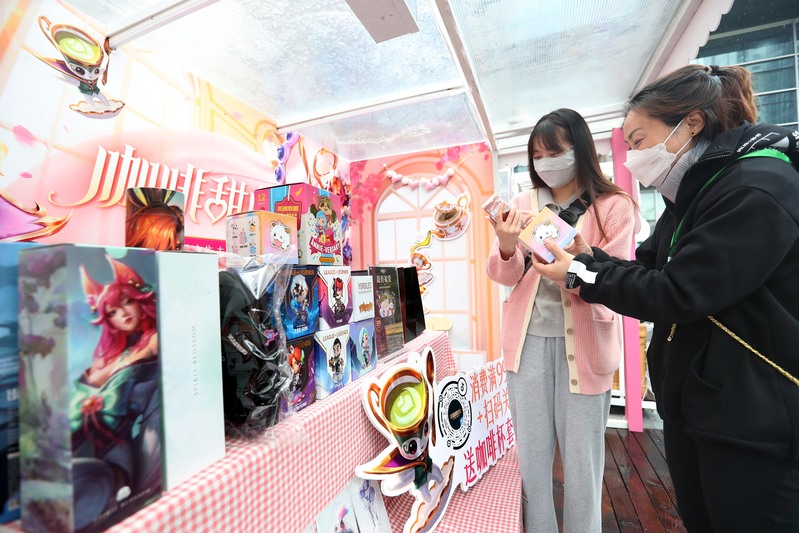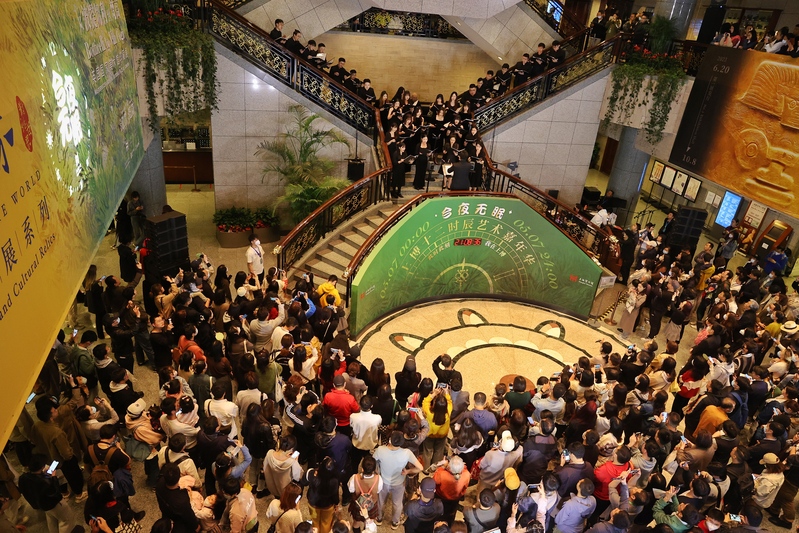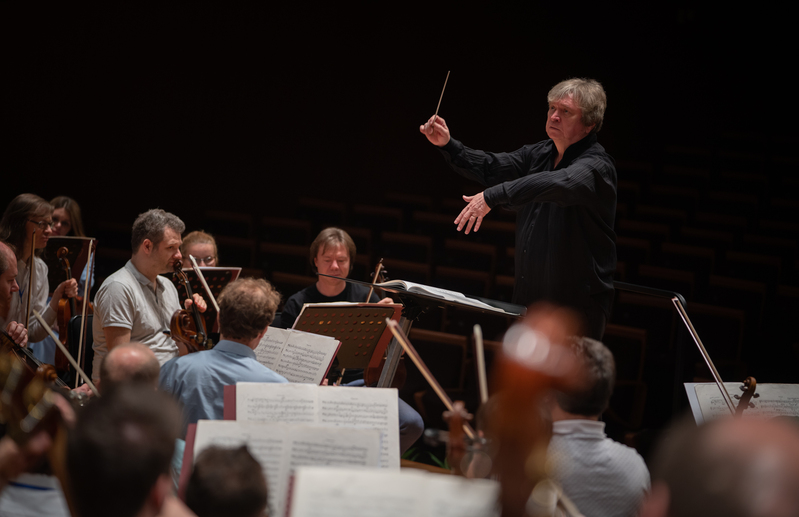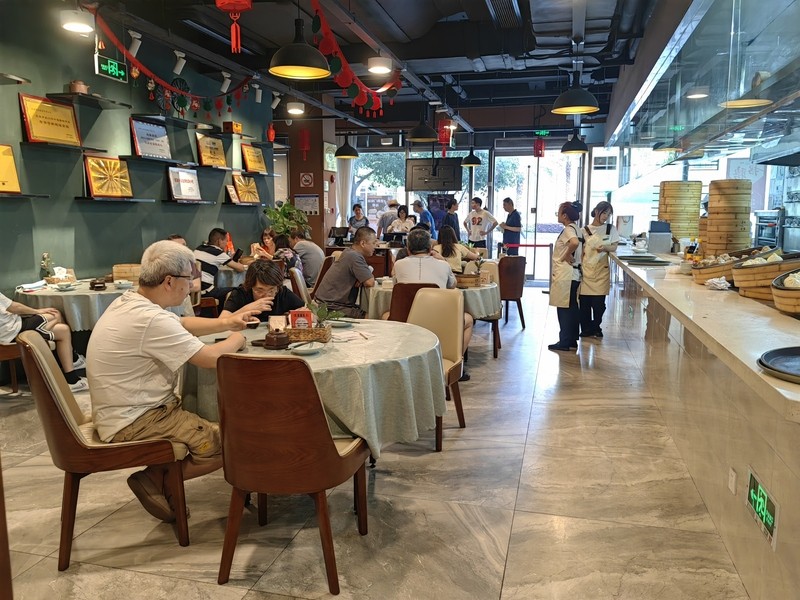In his eyes, Shanghai should attract people with a high-quality lifestyle, and business school professors are also art exhibitions, classical music enthusiasts, and urban culture | Shanghai | traffic | cultural and business travel | cultural and tourism
Currently, China's consumer market is showing a recovery and growth trend, with strong consumer resilience, great potential, and abundant vitality. Shanghai, which has been striving to build an international consumption center city for many years, has received much attention on how to grasp the above consumption growth trends through cultural, commercial, and tourism channels.
Professor Chen Xinkang from the School of Business at Shanghai University of Finance and Economics and President of the Shanghai Marketing Association has been studying the above issues for many years.
Recently, Professor Chen compiled his recent reflections on important events such as the May 5th Shopping Festival, Shanghai Coffee Culture Week, and Shanghai International Film Festival.
Attracting external purchasing power is an important ability
I have been studying how Shanghai can achieve the goal of becoming an international consumption center city for many years. This year, I have paid special attention to the market consumption data performance of Shanghai at two time points. One is the Spring Festival, and the other is the recently passed Labor Day.
According to data from Sohu City, during the 7-day Spring Festival holiday this year, Shanghai received a total of 10.0229 million tourists and generated tourism revenue of 16.64 billion yuan. After calculation, the average consumption per tourist is about 1660.02 yuan. In 2019, the average consumption per tourist in Shanghai was around 1446 yuan.
During the 5-day holiday of May Day this year, Shanghai received a total of 15.6494 million tourists. The number of tourists attracted during these 5-day holidays has increased by almost half compared to the 7-day Spring Festival. However, although the number of tourists has increased by over 5 million, tourism revenue has not correspondingly increased by half. If we look at per capita consumption, the per capita consumption during the 5-day holiday of May Day is actually slightly lower than that during the 7-day period of the Spring Festival.
How do you view the results obtained from comparing this set of data? I believe that the following conclusions can be drawn: firstly, the daily consumption of tourists coming to Shanghai will not be diluted due to prolonged holidays, nor will it increase due to tight holidays. Today's consumers have gradually formed a habit of rational choice in their consumption behavior, and their daily consumption needs can be easily met. Under such circumstances, relying solely on travel during holidays does not have a significant stimulating effect on consumption. Simply put, higher quality and more distinctive "deep tours" have become a battleground for the cultural, commercial, and travel industries.
Secondly, with the overall recovery and growth trend of China's consumer market, and the general return of people's convenience in daily life and travel to normal, tourists have a very diverse range of choices. In a highly competitive environment where there are a wide range of destinations and entertainment and leisure projects to choose from, and various regions are striving to attract tourists to consume, if a city does not form a clear and attractive consumption destination and distinctive consumption activities for foreign tourists, it will be difficult for it to have particularly impressive performance in the daily consumption data of tourists.
For Shanghai, since it has set the goal of building an international consumer center city and aims to become a comprehensive consumer city with global appeal, it is necessary to actively enhance its attractiveness to foreign purchasing power and strive to expand its profit ceiling. In other words, whether an international consumer center city can be built depends on whether it can attract more foreign purchasing power. The foreign purchasing power referred to here includes purchasing power from the Yangtze River Delta and various parts of the country, as well as purchasing power from overseas.

Building an international consumer center city is not only a pursuit in the field of commercial circulation, but also a requirement for the endogenous driving force of Shanghai's economic development. In order for Shanghai's urban economy to achieve stable and sustainable development, consumption must become one of the important driving forces that can drive Shanghai's economic development. Therefore, attracting foreign purchasing power is not just a strategy or choice, but an important ability that must be improved with effort.
The Shanghai Jing'an World Coffee Culture Festival, with the theme of "falling in love with Jing'an in a cup of coffee," opened at the South Square of Jing'an Kerry Center and Anyi Night Lane. The Türkiye coffee, which is good and fun to make, can satisfy the people's eyes as well as their mouths.
Utilizing the clustering advantage of high-end resources to provide high-quality living experiences
During this year's May Day holiday, many friends who went out for sightseeing and returned generally reported to me that the ability and service awareness of receiving foreign tourists in various regions have significantly improved. Especially in commercial districts and streets that excel in retail, hardware, software, and the ability to combine virtual and real online and offline have all been upgraded. Looking back, it seems that our commercial districts and streets in Shanghai do not have any particularly obvious advantages. I am not surprised by everyone's feedback.
The basic principle of healthy competition must be to leverage strengths and avoid weaknesses. So, in my opinion, if Shanghai wants to build an international consumer center city, it must consider its own advantages. At present, Shanghai has two advantages that can be leveraged: one is the agglomeration advantage of utilizing high-end resources, and the other is the provision of high-quality living experiences.
Shanghai's high-end resources can be analyzed from these aspects. One is retail. We have so many commercial districts, both traditional and trendy, and the operating area of physical retail stores in Shanghai is among the best in the country. We have a certain advantage in this type of resource, but this advantage is already weakening and may even disappear in the blink of an eye.
In contrast, the high-end resources that Shanghai can truly gather advantages in the future mainly include culture, art, sports, education, and healthcare. Among them, Shanghai has obvious advantages in education and medical resources, but they are not within the scope of market consumption. What can be discussed from the perspective of market consumption is culture, art, sports, etc., and culture, art, sports are precisely important areas that can provide people with high-quality life experiences.
Providing a high-quality living experience is definitely helpful for Shanghai to enhance its attractiveness to foreign buyers. For example, the recent Coffee Culture Week held in Shanghai not only made the public aware, but also revealed that the number of coffee shops in Shanghai has exceeded 8500. With various unique and creative coffee shop owners, baristas, coffee experts, and coffee brands, it has allowed everyone to see the rich and diverse possibilities of high-quality living, as well as the multiple facets beyond the fast-paced lifestyle in Shanghai. Drinking coffee can be leisurely, enjoying life, stimulating creativity, encouraging communication, embracing diversity, and drawing on the strengths of others... Nowadays, Shanghai has the world's largest number of coffee shops. Over time, if Shanghai can provide a richer, more exciting, and diverse high-quality life experience, I believe it will definitely become one of the most popular travel destinations in the world.
There are roughly three characteristics of a high-quality life. Firstly, the proportion of intangible spiritual consumption gradually exceeds that of tangible material consumption. Secondly, people are increasingly pursuing the achievement of personal feelings and experiences. The phenomenon of following the trend in consumption will be reduced, and more consumers will consider their consumption choices based on their subjective feelings and cognition. Thirdly, benchmark against international high standards.
Although there is no unified international standard for what "high-quality life" means, people around the world share the same pursuit of knowledge, beauty, and higher-level spiritual life, as well as the desire to realize personal value. For these common needs and pursuits, it is worth considering for every professional who is willing to create a higher quality life for everyone.

Moreover, the reason why culture, art, and sports have become important areas for providing people with high-quality living experiences is also due to the fact that the resources in these areas have a characteristic - it is difficult to replicate them simply, and the production and consumption of these resources mostly need to be carried out simultaneously.
When we go to a concert, an exhibition, or a sports event, people must be present and feel unparalleled, irreplaceable, and irreplaceable. From this perspective, such resources have very obvious advantages. Since Shanghai has advantages and foundation in gathering these high-end resources compared to other cities in China, there is no reason not to form its own characteristics and grow stronger.
The world's most popular competitive game under the "Fist Game" brand, League of Legends, features multiple mysterious heroes at the Shanghai Jing'an World Coffee Culture Festival. The booth provides a sweet coffee experience that spans between virtual and real worlds, and offers League of Legends limited coffee peripheral gifts.
The key to transforming cultural, business, and tourism from "traffic" to "retention" is to work together and make efforts
Many friends have discussed with me: Shanghai is not lacking in cultural, artistic, and sports resources. Why hasn't the ability to attract foreign purchasing power significantly improved and enhanced in recent years?
The result of our discussion is that Shanghai has resources, but there is a lack of linkage between different resources and no mechanism for joint efforts. Because there is no coordinated effort, all of our actions are often scattered and it is difficult to form a cohesive force.
Give a recent example. Not long ago, the "From Botticelli to Van Gogh - National Gallery of Fine Arts Collection Exhibition", which lasted for more than three months, officially closed. Since its launch on January 17th, over 420000 visitors from all over the country have come to visit, setting a new record for the number of visitors to paid exhibitions in domestic museums. It is reported that over 60% of the audience came from other provinces and cities, and 15% of the audience visited more than twice. One of the most special viewers watched it 12 times in a month. The attraction of high-end cultural exhibitions is evident.
I also bought a ticket to go there, but due to my career sensitivity, I paid special attention to a few phenomena while waiting in line for entry. For example, at least half of the foreign tourists come to visit, but the vast majority of them only come to watch the exhibition and go straight home after watching it. This means that when our exhibition finally attracted them to Shanghai, we were unable to successfully keep them and stay longer.
If these tourists can go to other nearby exhibition halls, commercial districts, and commercial streets for leisure and consumption, experience services and cuisine at distinctive restaurants, stay overnight in nearby hotels, and then visit other exhibition halls, creative parks, theme parks, etc. in Shanghai the next day, wouldn't it be even more beautiful?
In the imagination of my friends and I, Shanghai is not lacking in goods and services that can provide value to foreign tourists. However, due to the lack of linkage between our exhibition halls, commercial districts, hotels, etc., and the lack of conscious and meticulous planning, it is very likely that we will lose contact with our target customers invisibly. This is very regrettable.

How to demonstrate linkage? If I were to plan it, I would design a main event called "Beautiful Mind Journey".
The timeline from Botticelli to Van Gogh is a long one. This line not only connects the history of Western art, but also the cultural changes of different eras. Similarly, while allowing tourists to watch the exhibition, why not mobilize the products, creative culture, hotel and catering resources related to the exhibition, so that they have the opportunity to experience a more rich and fulfilling "beautiful spiritual journey"?
For example, not far from the Shanghai Museum, there are the Shanghai Grand Theatre and the Shanghai Concert Hall. They are not only iconic buildings with rich historical and cultural connotations, but also the stage or residence of many famous artists, and have performed or are currently performing high-quality performances. Can they collaborate with art exhibitions to hold salons or performances on related themes? Can we design some linkage between performance tickets and art exhibition tickets to provide package discounts?
Can the Peace Hotel and International Hotel, located not far from People's Square, provide special discounts for visitors holding art exhibition ticket stubs?
Can the surrounding restaurants create corresponding derivatives for the art exhibition and develop some distinctive meals and sets?
Can some shopping malls in the surrounding commercial area that feature imported and artistic products be specifically selected to interact with exhibitions, or even organize sources of goods and plan special exhibitions for products?
Through this linkage, consumers will definitely be able to achieve both material and spiritual harvests, and return happily with a full load.
This reminds me of the Oriental Art Center located on Dingxiang Road in Pudong New Area, Shanghai. In the past few years, due to factors such as the epidemic, the characteristic project of the Oriental Art Center, "Top Ten Symphony Orchestras of the World Coming to Shanghai for Performance," has been temporarily suspended. It is reported that in June, the St. Petersburg Philharmonic Orchestra made its third appearance on the stage of the Oriental Art Center, and sold out within 48 hours of invoicing. When such rare performance resources are about to arrive as promised, can the relevant organizers, surrounding business districts, and merchants also plan in advance and work together to provide consumers with unparalleled high-quality life experiences?
I have watched several performances of top foreign symphony orchestras at the Oriental Art Center, during which I witnessed tourist buses from Zhejiang and Jiangsu coming one by one, picking up the audience after the performance. How to create conditions and opportunities to make them stay in Shanghai longer is a topic worth exploring. The core behind it, I think, is the deep linkage between culture, commerce, and tourism.
To my knowledge, many overseas bands who come to perform at the Oriental Art Center live in nearby hotels. It is an internationally accepted practice to organize master classes, workshops, academic forums, and other activities that allow audiences, citizens, and artists to have more interaction, without affecting the normal performance and rest of performers. This allows art enthusiasts, local artists, art professionals, teachers and students, and professional artists to have more opportunities to learn and exchange ideas. The good experience in this area is also worth learning and learning from for practitioners in the cultural, business, and travel industries.

The audience watched the performance of the Rainbow Chamber Choir at the Sleepless Twelve Hour Art Carnival tonight.
Establishing a unified information service platform to help consumers save time and worry
To achieve deeper and more active interaction among culture, commerce, and tourism, there must be a fully functional "infrastructure". That is a unified information service platform.
In theory, people's desire to purchase needs to be stimulated, and the triggering of consumption needs beyond daily necessities is even more so. For modern people, in order to obtain high-quality life and spiritual enjoyment, it is even more necessary to obtain it through high-quality information dissemination. This is reflected in the fields of culture, commerce, and tourism, which requires a high-quality and highly integrated information platform.
When we go to well-known tourist cities abroad, we can quickly locate similar web pages through the city's portal website. Essentially, it is the unified information platform for culture, commerce, and tourism in this city. This platform reflects a city's service awareness, service level, and attitude towards foreign tourists, and is not contradictory to commercial tourism information service websites.
Nowadays, when foreign tourists come to Shanghai for travel, exhibitions, performances, and hotel stays, they seem to have to rely on their own exploration of the activity destination, or on browsing recommended articles by bloggers and influencers. This does not mean it is impossible, but it invisibly increases the time and trial and error costs for tourists to obtain effective information, which could have been avoided.
Moreover, further speaking, the lack of an authoritative and unified information platform invisibly limits the imagination of tourists towards their own needs, and is not conducive to them finding the information and solutions they need more quickly. For businesses and various cultural, commercial, and tourism destinations, they have also missed out on a relatively concentrated opportunity to acquire potential customers and meet potential partners.
In fact, information platforms are also service platforms. As long as organized, designed, and planned properly, a platform can solve various functions such as information integration, information linkage, hotspot push, traffic guidance, service retrieval, clarification, complaint feedback, etc. This is not difficult to solve technically. If the basic service work is done well, it will definitely be helpful for Shanghai to attract more foreign tourists and improve tourist satisfaction. Perhaps we do not currently lack relevant information dissemination platforms, which are more scattered in various media and channels. Therefore, we need to put more effort into promoting and promoting these platforms to facilitate the awareness of foreign tourists.
There is a concept in business theory called "customer assets". Simply put, both customers themselves and their satisfaction, recognition, opinions, and suggestions are "hidden assets" that can help enterprises achieve significant development. In this sense, Shanghai's advantageous resources including culture, commerce, and tourism should further enhance its service awareness and open up to customers. In this way, the construction of Shanghai International Consumer Center can have a more solid foundation.
On June 25th, the Saint Petersburg Philharmonic Orchestra, a top international symphony orchestra, made its third appearance on the stage of the Oriental Art Center Concert Hall.





